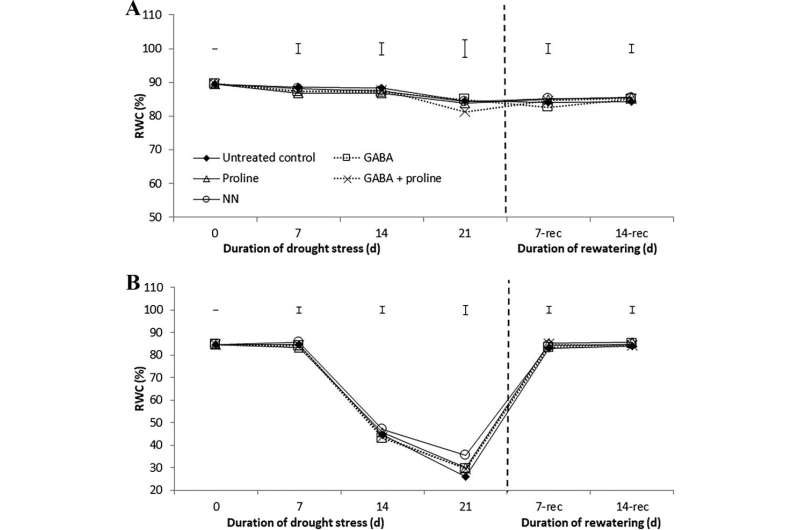Changes in leaf relative water content (RWC) of creeping bentgrass (Agrostis stolonifera cv. Penncross) treated with water (untreated control), gamma-aminobutyric acid (GABA), proline, GABA + proline, or ammonium nitrate (NN) for 21 d under either (A) well-watered or (B) drought conditions, and 14 d of rewatering. rec = recovery/rewatering period. Vertical lines indicate least significant difference values for the comparison of treatments at P ≤ 0.05 at a given day of treatment. Credit: Journal of the American Society for Horticultural Science (2022). DOI: 10.21273/JASHS05215-22
Drought stress can interrupt the metabolic and physiological processes of plants, including nitrogen and amino acid metabolism. Researchers in the Department of Plant Biology at Rutgers University took a closer look at the role of amino acids and nitrogen on cool-season turfgrass regrowth or recovery from drought stress.
The objectives of this study were to examine how gamma-aminobutyric acid (GABA) or proline, alone and in combination, or inorganic nitrogen [ammonium nitrate (NN)] may differentially affect turf performance during drought stress and rewatering. The authors also sought to determine how these nitrogen-enriched compounds might be involved in regulating the endogenous accumulation of other amino acids during drought stress, contributing to post drought recovery.
Creeping bentgrass sod plugs (Agrostis stolonifera cv. Penncross) planted in porous ceramic fritted clay medium were exposed to well-watered conditions or drought stress by withholding irrigation for 21 days in growth chambers.
Plants were treated with water (untreated control), GABA, or proline alone and in combination, or NN through foliar spray before drought stress and every 7 days during the 21-day stress period. For post drought recovery, at 21 days of drought treatment, plants were rewatered for 14 days to return soil water content to prestress levels.
Results from this study indicate that exogenous application of GABA significantly improved turf growth under drought stress but did not enhance re-greening or regrowth of plants once the stress was relieved during rewatering, suggesting that GABA is mostly effective in protecting plants from drought stress.
Application of inorganic NN was effective in promoting rapid post drought recovery and regrowth potential through the activation of amino acid metabolism. Proline showed positive effects on enhancing plant tolerance to drought stress, as manifested by increased leaf relative water content and other canopy parameters, as well as post drought recovery on rewatering.
The study shows that endogenous amino acids, including GABA, proline, alanine, and glutamic acid, may be used as biomarkers to select for drought-tolerant plants and biostimulant components for improvement of drought stress tolerance and post stress recovery in cool-season turfgrass species.
According to the author, Bingru Huang, Department of Plant Biology, Rutgers University, "Nitrogen-enriched organic molecules, GABA and proline, were more effective to protect plants from drought damages or promote drought tolerance while inorganic nitrogen was more beneficial for stimulating plant recovery from drought stress"
The research was published in the Journal of the American Society for Horticultural Science.
More information: Cathryn Chapman et al, Differential Regulation of Amino Acids and Nitrogen for Drought Tolerance and Poststress Recovery in Creeping Bentgrass, Journal of the American Society for Horticultural Science (2022). DOI: 10.21273/JASHS05215-22
Journal information: Journal of the American Society for Horticultural Science
Provided by American Society for Horticultural Science
























